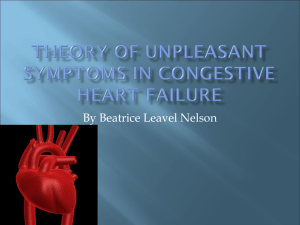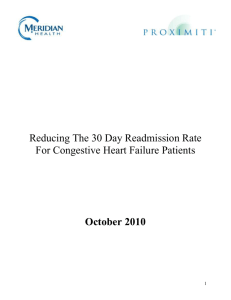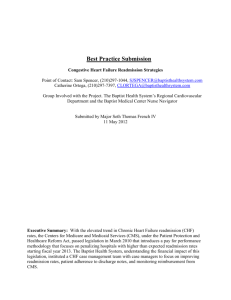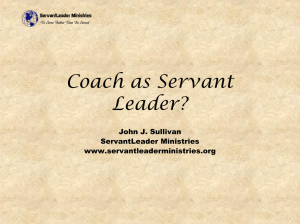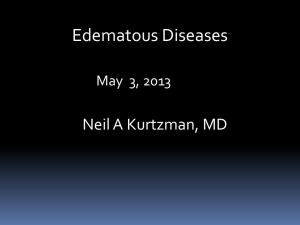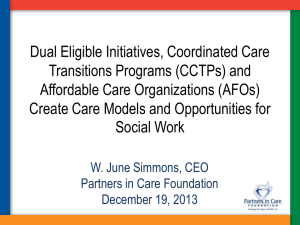Transitions in Care, aka Reducing Readmissions
advertisement
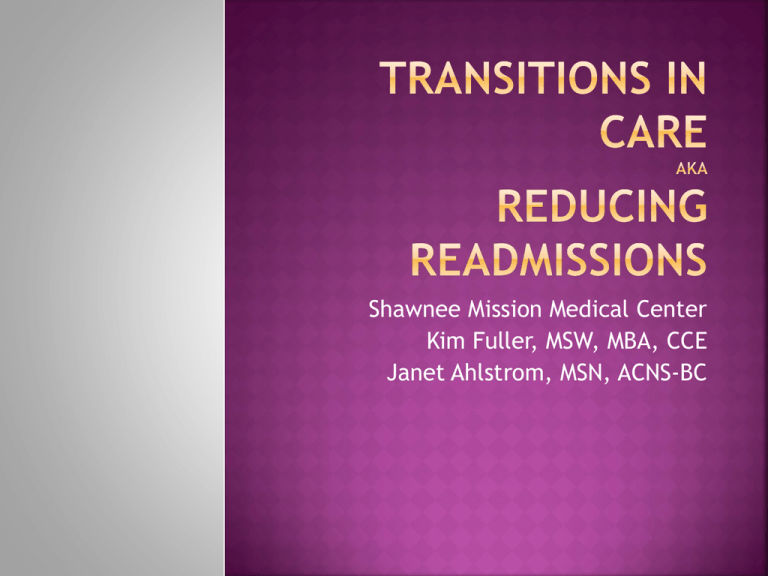
Shawnee Mission Medical Center Kim Fuller, MSW, MBA, CCE Janet Ahlstrom, MSN, ACNS-BC Selected populations: Congestive Heart Failure Pneumonia Acute Myocardial Infarction (AMI) IHI Collaborative on Reducing Readmissions in 2009/2010. Developed multidisciplinary internal team to participate in the Collaborative and to begin designing program. Did chart reviews of readmissions to assess patterns, failure points, potential interventions and conducted tests of change. Discovered many readmissions coming back from SNF’s, so invited key partners to join Collaborative. Split internal team and external community partner group into separate meetings. Justified initial addition of an FTE by quantifying potential cost to the bottom line following implementation of CMS penalties. Hired .5 MSW and .5RN and Transition Coach role fully implemented in August, 2011. Enhanced Admission Assessment for Post Hospital Needs Effective Teaching and Enhanced Learning Real – time Patient and Family Centered Handoff Communication Post-Hospital Care Follow Up Membership includes: Nursing representation from cohort areas for CHF, AMI and Pneumonia. Pharmacy Social Work/Utilization Review Ask a Nurse Call Center SMMC Home Health Cardio-Vascular Services Nursing Education Membership includes Home health Skilled nursing facilities Assisted Living Facilities Hospice Private Duty LTAC Emergency Medical Response Case studies of readmissions from various facilities, identifying breakdowns and creating new processes. Education re: disease specific protocols provided to SNF’s. i.e. importance of daily weights and use of the zone chart for CHF patients. Development of common hand off tool that meets needs of hospital and external agencies. Strategies to increase involvement of palliative care and hospice when appropriate. Education about national movement toward use of Transportable Physician orders for End of Life treatment wishes. Development of special interest sub-committees to concentrate and problem solve issues that are unique to different settings. Trend readmission data specific to various agencies/facilities to use in forming stronger community partners with those that have lower readmission rates. Shawnee Mission Medical Center Melanie Davis-Hale, LMSW Cathy Lauridsen, RN, BSN 0.5 Social Worker/ 0.5 RN Identify high risk patients in hospital Initiate individualized program Follow for 30 – 45 days regardless of setting Facilitate smooth TRANSITIONS Early intervention with any readmissions Meet weekly with physician champions at SMMC Provide education for patients and healthcare team partners Currently utilizing the Better Outcomes for Older adults through Safe Transitions (BOOST) Tool Collaborative Care Team (CCT) process at SMMC Chart review of Electronic Medical Record 8P screening tool: Problem Medications –(anticoag, insulin, aspirin, digoxin) Punk (depression) - screen positive or diagnosis Principle diagnosis – COPD, cancer, stroke, DM, heart failure Polypharmacy - >5 or more routine meds Poor health literacy - inability to do teachback Patient Support – support for d/c and home care Prior Hospitalization - non-elective in last 6 months Palliative Care – pt has an advanced or progressive serious illness Initial contact with patients/family during the hospitalization. Schedule follow-up PCP/Specialist appointment prior to hospital discharge. Follow patient across all levels of care for up to 45 days post discharge. Phone/in person home visits. Continually assess patient needs post discharge. Medication Follow Patient management up with PCP/Specialist centered record Knowledge of Red flags and how to respond Develop a relationship with patient and/or family prior to hospital discharge Identifying patients’ healthcare goals Matching patients to Social Worker or RN based on patient needs Financial needs Psycho-Social needs Community resources Patient/Family/Caregiver Education Facility/Service Provider Education Symptom management Interventions to prevent readmission based on patients’ discharge plan Visit/phone call to patient, patient’s nurse, social worker, PT/OT, Medical Director. Ensure patient has seen Medical Director within 72 hours Identify medication issues/concerns/changes and other areas of symptom management. Awareness of patient discharge plan from facility Maintain communication with patient’s PCP/specialist Prepare patient for transition to lower level of care/home Collaborate with Home Health Agency/Case Manager to develop care plan to prevent readmission Ensure patient attends follow-up PCP/specialist appointment Continue post-discharge education to patient/family/caregiver Identify medications issues/concerns Identify and referred to needed services Encourage self-management when possible Identifying patients that will code out as CHF, Pneumonia, AMI Continually educating service providers on role of transition coach End of life issues August 2011 - December 2011 Total # of Patients Followed by Transition Coaches Total # of Medicare Patients Discharged from SMMC 154 141 60 50 42 15 7 CHF PNA AMI Other DRGs SMMC CHF Readmission Rates August 2011-December 2011 Non-Transition Coach Transition Coach 47% (8/17) 38% (5/13) 35% (8/23) 31% (4/13) 25% (7/28) 17% (4/23) 17% (2/12) 13% (1/8) 0% (0/9) August September 0% (0/8) October November December SMMC PNA Readmission Rates August 2011-December 2011 Non-Transition Coach Transition Coach 100% (1/1) 33% (1/3) 23% (6/26) 17% (1/6) 23% (3/26) 11% (3/27) 0% (0/2) August September 10% (3/30) 0% (0/17) October 0% (0/3) November December SMMC AMI Readmission Rates October 2011-November 2011 Non-Transition Coach Transition Coach 23% (3/13) 0% (0/3) October 0% (0/4) November 25% (0/4) Where Transition Coach Patients Readmitted From August 2011-December 2011 SNF 30% Home Health 40% Home 30% Pt originally admitted to hospital for: Pt admitted from: Pt discharged to: Readmission reason: PNA Home SNF Dehydration CHF Home w/ Home Health SNF CHF CHF SNF SNF CHF CHF Home Home w/ Home Health CHF CHF Home Home w/ Home Health Hemorrhage of Gastrointestinal CHF Home w/ HH Home w/ Home Health Transient Cerebral Ischemia CHF Home Home w/ Home Health A-Fib PNA Home Home Mitral Valve Disorder CHF Home Home CHF PNA Home Home Pulmonary Embolism Kim Fuller 913-676-2293 Kim.fuller@shawneemission.org Janet Ahlstrom 913-676-2032 Janet.ahlstrom@shawneemission.org Cathy Lauridsen 913-676-8611 Catherine.lauridsen@shawneemission.org Melanie Davis-Hale 913-676-2168 melanie.davis-hale@shawneemission.org
